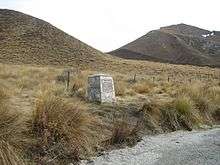Acclimatisation societies in New Zealand
Acclimatisation societies were established in New Zealand by European colonists from the 1860s, with the first likely having been established in Auckland around 1861.[1]

The Otago Acclimatisation Society was operating by 1864. By 1869, it was receiving £500 per year from the Otago provincial government to bring in familiar British species, notably small birds, such as starlings, blackbirds, sparrows, chaffinches, of which populations thrive around Dunedin today.[2]
In 1867 the first of a series of Animal Protection Acts was passed to provide protection to many of the introduced animals and formally recognised the Acclimation Societies in New Zealand. Later that year the importation of Trout and Salmon was enabled by the passing of the Trout and Salmon Act.[1]
Wellington's Acclimatisation Society got under way in May 1871 with 62 members. President A.Ludlam, vice presidents: Archdeacon Stock, Dr Hector, J. C. Crawford. Their first committee was: Hunter, Pearce, Krull, Laing, Bannatyne, Denton, Travers, G. Bennett, W Levin and Dr Johnston.[3][4]
The Canterbury acclimatisation society was known for some more unusual introductions including the African Lion. Not only did they import animals, but they also exported them. For example, in 1872 the Whanganui society exported kiwi to Adelaide in exchange for rooks.
They received some financial assistance from government, for example £150 from the provincial government of Canterbury in 1867[5] and £300 from the national government in 1905.[6]
Affiliation
To "speak to the government with a united voice on any special subject"[7] a formal association of acclimatisation societies was approved at their annual conference in Wellington in the summer of 1903 and given the name New Zealand Acclimatisation Society. The first president was J. B. Fisher of Canterbury.[8]
Fish and Game New Zealand
In 1990 they became regional fish and game councils – together, Fish and Game New Zealand.[9]
Species Introductions
There were many species attempted to be introduced to New Zealand. Successful introductions to New Zealand Include [10]:
See also
References
- "Early acclimatisation societies". Te Ara. Retrieved 6 May 2011.
- West, Jonathan (March 2018). The face of nature : an environmental history of the Otago Peninsula. Dunedin, New Zealand. p. 236. ISBN 1927322383. OCLC 994517936.
- Acclimatisation Society. Wellington Independent 2 May 1871 Page 2
- The Evening Post 2 May 1871 Page 2
- "Acclimatization Society". Lyttelton Times. 4 June 1867. p. 6. Retrieved 1 January 2016.
- "The Supplementary Estimates". New Zealand Herald. 31 October 1905. p. 6. Retrieved 1 January 2016.
- Acclimatisation Conference. Evening Star 24 January 1903 Page 3
- [James Bickerton Fisher Conference of Acclimatisation Societies. Otago Daily Times] 26 January 1903
- Walrond, Carl (24 November 2008). "Acclimatisation - Fish and game councils". Te Ara – the Encyclopedia of New Zealand.
- "Introduced Birds and Mammals in New Zealand and Their Effect on the Environment | NZETC". nzetc.victoria.ac.nz. Retrieved 4 May 2019.
External links
- Te Ara - the Encyclopedia of New Zealand - Acclimatisation of Animals
- Te Ara - Early acclimatisation societies